It is no wonder that the gods choose to convene in Shimane Prefecture, I was thinking as my plane approached Izumo Airport. Below, blue mountains extended from a pearly grey sky, with golden rice fields stretching along the foot of the mountain flanks before tumbling into one of the prefecture’s two lakes.
The first to settle here, according to one of Japan’s oldest books, the Kojiki, was the Shinto god Okuninushi. And dedicated to him is one of the country’s oldest Shinto shrines, Izumo Taisha Grand Shrine, where a number of age-old Shinto festivals continue to be held each year.
“The myriad gods throughout the country come and stay for about a week”, commented Akiyo Kuwamoto, a member of Shimane Prefecture’s Tourism Promotion Division, when I ask about Kamiarizuki (the month with gods).
Shimane faces the Korean Peninsula and China across the Sea of Japan, and this thin slip of a prefecture has long served as a first point of entry to Japan. Over the centuries, traders, explorers and gods have come, and their legacies are the stories that remain part of daily life here.
Born and raised near the shrine, Kuwamoto described how the gods are carried from Inasa-no-hama, a beach with a pine topped rock on the shore where they first gather, to Izumo Taisha Grand Shrine.
“Many people say there are more gods than people during that time”, she chuckled, as we drove towards the capital, Matsue.
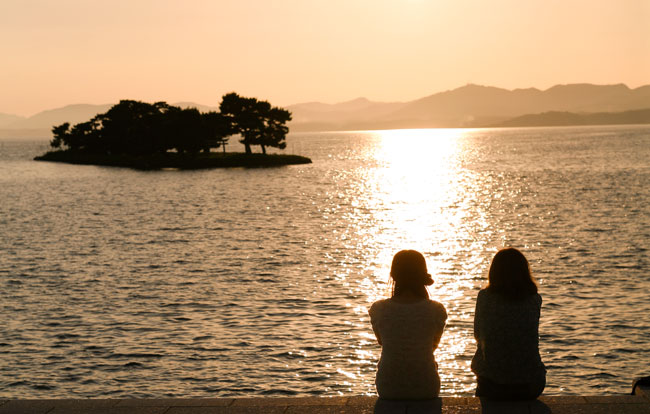
Lake Shinji
A national treasure
Our first stop is Matsue Castle, which has sat at the heart of the city since its completion in 1611. Built by Yoshiharu Horio, it is one of only 12 of Japan’s remaining original castles. Its black outer walls reach up into the brilliant blue sky, while inside a breeze wafts in from windows and openings in the floor (convenient for dropping stones on invaders) over smooth wood floors. A series of stairs carries us past displays of armour and historical scrolls up to the very top.
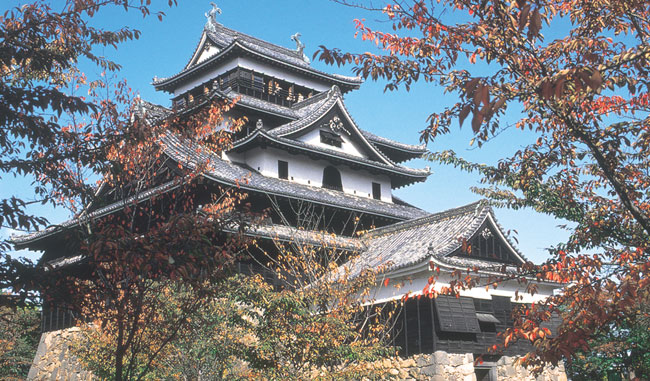
Matsue Castle is one of only 12 original castles in Japan.
Slated for demolition during the Meiji period, Matsue Castle escaped the fate of so many other similar strongholds of its time when a group of citizens lobbied the local government to preserve the keep. Led by Motoemon Katsube and a former retainer of the Matsue domain, Gonpachi Takagi, the castle was saved and remains a centrepiece of community life. It was designated a National Treasure in 2015.
Gazing out over the city, it is possible to imagine the satisfaction Horio perhaps felt at this spot as the city bustled below. Lake Shinji shimmers in the distance, and an old-fashioned Horikawa sightseeing boat passes under a bridge over the outer moat.
The historical district is nearby, home to Lafcadio Hearn’s museum and a recreation of an old samurai residence that serves as the Matsue History Museum. From here, too, the distinct painter’s palette-shaped roof of the Shimane Prefectural Art Museum is easy to spot.
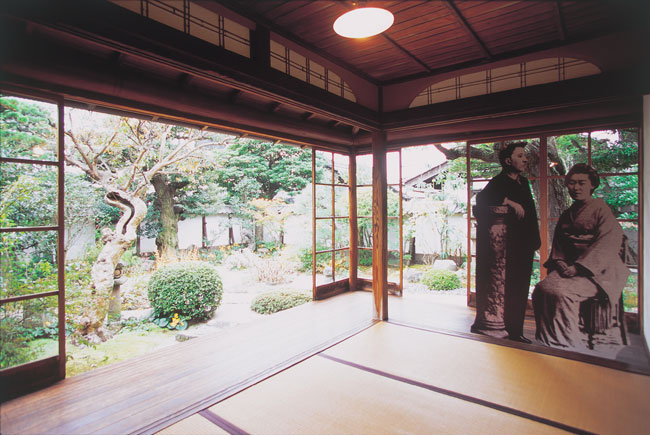
The former home of Lafcadio Hearn is much the same as it was 125 years ago.
A few steps away from the castle is the Lafcadio Hearn Memorial Museum and his former residence. Hearn, a 19th-century journalist, made his way to Japan from his birthplace in Greece via Ireland and the United States. He found himself, as have so many non-Japanese since, teaching English at a local school. Stepping through the gate to the courtyard in front of his former residence, the noise of the street disappears. The house, its garden and pond remain much the same as they were 125 years ago when he lived here.
It was during this time that Hearn heard the first of what would become the inspiration for his most famous work—a collection of traditional Japanese ghost stories called Kwaidan—which would help introduce this recently opened country to the world. While in Matsue, Hearn met and married Setsu Koizumi and took her family name when he became a naturalized citizen in 1896.
Next door is the museum run by Hearn’s great grandson, Bon Koizumi. His wife, Shoko, a coordinator there, showed me around the newly refurbished and expanded facility. Visitors watch a short film—in English with Japanese subtitles—that offers an overview of Hearn’s life, before entering the exhibition rooms.
“It was while living in the US that Hearn became enthralled with the Kojiki”, Koizumi told me as we walk past cases containing Hearn’s clothes, eyeglasses and suitcases.
One room contains first editions of each of Hearn’s works, along with copies of his newspaper articles. Interactive displays offer spine-tingling tales from Kwaidan, told by the actor Shiro Sano and accompanied by Kyoji Yamamoto on guitar. There is also a long list of individuals—including Japanese poet Yone Noguchi and Albert Einstein—who were influenced by Hearn’s writing.
“Perhaps the most famous story is that of General MacArthur”, Koizumi told me. “He asked an aide to find some information about Japan once he knew he would be sent here after the war. His aide showed him this book”, she said pointing to a first edition of Japan: An Attempt at Interpretation.
“MacArthur read it and then all of Hearn’s other works. He said he came to understand Japan’s culture and people because of it, and it is said this is one reason the general advised that the emperor should retain the throne at the end of World War II. He understood that, for the Japanese people, the emperor was a symbol of continuity and cohesion”.
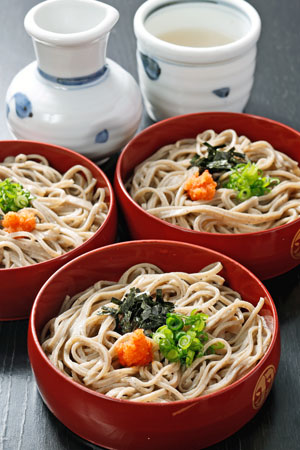
Izumo soba is darker and more aromatic than usual.
Shimane’s history is rooted not just in mythology and castles, but also in its soil.
“There is so much good food here”, said Kuwamoto as we drive to Daikonshima, a small island only recently connected to the mainland by a levee road.
“From the mountains, from the sea, from the fields”, she said, gesturing towards the landscape. Famous for seven food items from the lake—seabass, prawns, eel, clams, carp, Japanese surf smelt and icefish—Shimane is also home to Izumo soba, a buckwheat noodle that is darker than regular soba, because the grain has not been husked.
“This makes the noodles more aromatic than usual”, added Kuwamoto. “Typically, it’s eaten warigo style, meaning that three different bowls with three different toppings are served. When one is nearly finished, the leftovers get tipped into the next bowl”.
Stomachs growling, we arrived at Yuushien Garden, where we ate and then strolled through the famous grounds, all the while getting a closer look at two of Shimane’s best-known products: peonies and ginseng.
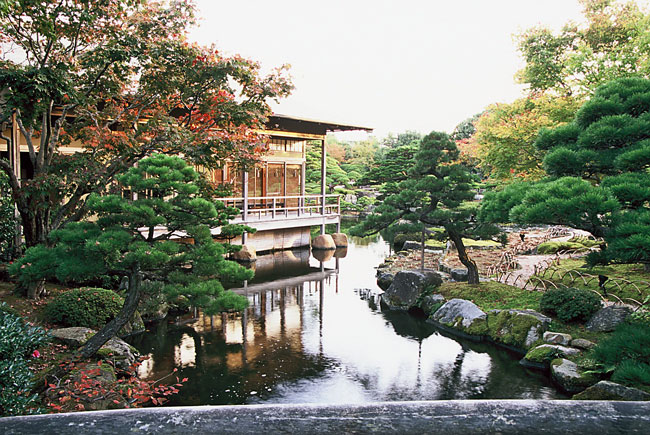
Yuushien Garden invites exploration.
The Korean wild root, valued for its health and beauty benefits, found a natural home in the slightly acid soil of Daikonshima, one of only three places in all of Japan where the root is raised. Visitors still flock here to enjoy the extensive gardens and taste this exotic herb.
“It’s very bitter, but good for you”, Kuwamoto said, holding up a tiny piece from her steaming bowl of miso soup. Indeed, ginseng is given credit here for everything from long life to beautiful skin and good digestion. I nibbled a piece and hoped for the best.
Soon, a round woven basket arrived, holding seven white cups containing tiny strips of dried seaweed, Japanese mustard, grated radish, crab, Japanese crackers, Japanese horseradish and thinly sliced spring onion.
As Kuwamoto explained, these are the ingredients for Shimane’s famed rice bowl, over which hot broth is poured before it is eaten.
“Take half your rice and top it with half of each of these items, pour the broth over it, and eat. Then repeat. This keeps the rice from getting soggy”, she advised, and as I followed her instructions, I tasted a highly satisfying local version of this national comfort food.
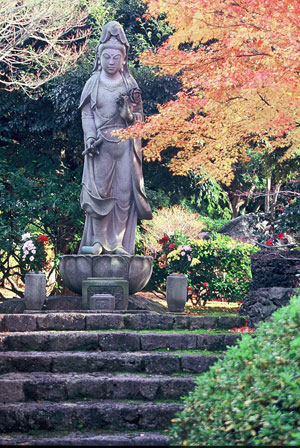
At Yuushien Garden, something is always in bloom.
Over the years, Yuushien has expanded gradually to more than 40,000m², with pines bending over carp-filled ponds, while staff carefully tend to the emerald green moss garden. Here something is always in bloom: peonies in spring, iris in summer, maples in autumn and, again, vividly coloured peonies in winter. An indoor peony garden provides a delightful and constant burst of colour.
“There are fireflies, too”, Inutani added as we catch sight of a brilliant turquoise kingfisher bird skimming over a stream.
Living art
In contrast to Yuushien’s strolling garden is the magnificent dry landscape of the rock garden at the Adachi Museum of Art. As breathtaking as the collection it surrounds, the garden is a masterpiece meant only for viewing.
“Our founder, Zenko Adachi, intended the garden to be part of the experience here”, said Fuyumi Yamane, curator at the museum, as we stand before the first of a series of huge windows framed in wood. Carefully spaced between exhibition rooms, the windows and their views of the garden make a natural break in every sense of the term.
We watch as a red maple leaf skips across the white sand, and rain deepens the green of leaves and draws out a shine on stepping stones leading to a small pond. The sand represents the sea, Yamane told us, while the rocks are mountains, and the gently rolling grassy hills symbolise flowing water.
“Adachi wanted so much to paint a picture with nature that he bought the distant mountains in order to ensure that the background would always be there”, she continued, emphasizing how each element of the garden was chosen just as an artist chooses a particular medium and colour for their work.
Every morning, Yamane told us with a smile, members of staff and seven professional gardeners together tidy the garden. They remove leaves and fallen branches and sweep away their tracks as they leave, to ensure that everything is picture perfect before the doors open. Both the paintings and the garden change with the season.
“The windows represent living art that changes throughout the year”, Yamane continued. “Zenko believed that, by pairing the paintings with the garden, visitors could more deeply experience both”.
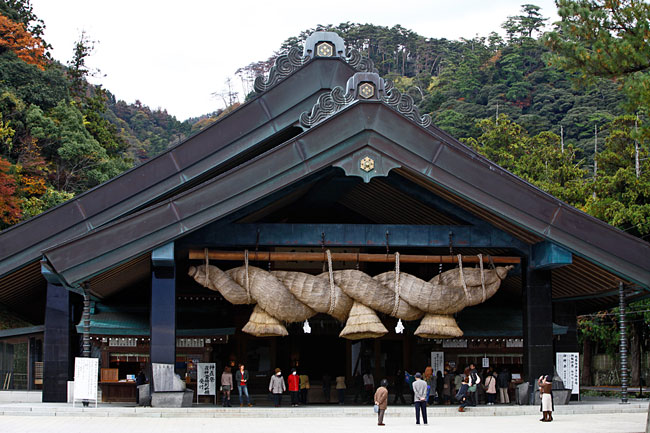
Izumo Taisha Grand Shrine is one of the oldest and most important shrines in Japan.
Living art is a recurring theme in Shimane, where life and work are so closely bound to spiritual traditions that it is nearly impossible at times to separate them. Here, deep in the mountains on a road that winds through tiny villages and terraced fields, are some of the best places to glimpse the heart of Shimane and, perhaps, Japan itself.
“There is the shrine to [the goddess] Kanayago”, said Daniel Broderick, Unnan City’s coordinator for international relations, as we pass a tall, traditional torii gate, as is commonly found at the entrance of a Shinto shrine. He and his counterpart, Yuriko Suzuki, also from Unnan City, took turns explaining how the goddess arrived riding a white heron and alighted on a tree. She then taught the Japanese how to make iron, creating an industry that lasted more than 1,400 years and made Shimane the heart of Japanese iron and sword production.
But, once Japan opened its borders in 1853, Shimane’s iron trade declined. By 1925 the last iron furnace had ceased production, marking the end of an era. However, in 1977, a group of citizens came together to build the Nittoho Tatara in Okuizumo to teach future generations the practices that had shaped their lives and traditions.
Outside the museum, a modern sculpture of Yamata-no-Orochi, the legendary eight-headed dragon—the tail of which produced the first samurai swords—soars overhead as we head to the entrance. Inside, Yutaka Ogata, former director of the museum, guides me through the traditional iron-making process—from the mining and sifting of the iron sand to the building of the clay furnace where the iron was made. “It took three days and three nights to make the iron”, Ogata told me as we looked at a life-size model of the furnace.
Three metres below the furnace is an intricate network of charcoal, stone and wood carefully constructed to manage moisture and keep the fire burning at a consistent temperature. Working all year, except for summer, using a process that would be repeated 60 or 70 times, the resulting iron eventually would be made into samurai swords, household wares or be shaped into bars that were exported around the country.
Shunji Kobayashi, a blacksmith who works the museum’s forge, offered an introduction rarely heard today.

Shimane’s rich tradition of iron making is still kept alive.
“As a result the whole will be stronger”, he added, before signalling to his apprentice and pulling the metal out once again. They tapped and pounded by turns, Kobayashi watching with a practised eye as the metal cooled and changed. It would be folded 12 to 15 times, resulting in upwards of 30,000 layers by the end of the month-long process of sword making.
Ogata told me that three families—Tanabe, Sakurai and Itohara—worked on their own forge, as well as co-operatively managing the land after the iron-bearing sand has been removed. Once cleared, the ground was terraced into fields where soba, then cattle and, finally, rice were raised.
“It was a very conscious process to work with nature in order to provide economic stability”, Ogata said as we left Kobayashi and the forge.
The Chugoku Mountains rose all around us to form the backbone of Shimane Prefecture and were once active volcanoes that produced the iron sand that fuelled Shimane’s early economy. Today, the enriched soil is fertile ground for both traditional and modern crops, including grapes, wheat and figs. As a result, Shimane is home to 32 sake breweries and two wineries. The gods chose well, I thought again, as we left the museum.
Traditions maintained
Hironari Koto’s shop is filled with stunning wrought iron—lanterns, candle holders and decorative wares—although at one time the display would have been very different. Swords were the main order of business when Koto’s grandfather founded it, over a century ago.
“Times have changed”, he says as he showed me a work chosen for inclusion in the 2016 Omotenashi Selection, a project that seeks both to discover Japanese products that embody craftsmanship of the highest degree while epitomizing the spirit of Japanese hospitality, as well as to present them to an international audience. The versatile piece serves as a vase, wind chime or candleholder. “People like our things because they represent good designs. We’ve aimed for durability, function and quality since the very beginning”.
Koto’s apprenticeship formally began when he was 18, but he was helping out around the shop and forge long before that.
“I started when I was in elementary school, helping before and after school”, he said, as we enter his workshop. There the smell of burning charcoal fills the air and four cats watch warily from a doorway. A shimenawa (ceremonial rope) hangs over the forge.
“Making iron is considered sacred work”, Koto answered when I asked about the rope. He tied a white towel around his head and positioned himself in front of the forge where a bed of hot coals sat glowing.
He worked the bellows with his left hand while moving the coals with his right. Sparks rose and fluttered, the flames coming to life in a flash of blue and orange.
“Now we use electric bellows”, he shouted over the roar of the fire, the heat of which reached me where I stood a few feet away.
“Before I could only heat something and then work it before putting it back in the fire. Now, I can do two things at once, so my work is harder”, he laughed.
He pulled a piece of metal out of the fire and struck it. The first hit with his wet mallet resulted in a loud pop, sending sparks flying in every direction. Each strike of the hammer shaped the metal and pounded out impurities that rise to the surface when the metal is heated.
“There is a big difference between moulded iron and this”, he said, pointing to the cooling metal. “This is stronger and more pliable. It’s made from 100% pure iron using ancient methods”.
The emphasis on preserving this tradition flies in the face of so many modern conveniences and even, some might say, common sense. However, its relevance and meaning are clear to Koto, who spoke of his work with a passion and reverence that I had seen and felt since having stepped off the plane.
“As the tenth generation blacksmith in my family, it is my mission to transmit this knowledge to the next generation and prevent the death of my tradition”, he told me as he worked the bellows again to reheat the iron.
“It is nearly impossible to reclaim knowledge once it is lost. A skill that has been passed down by hand is impossible to recreate with machinery because it requires human intuition and experience”, he said before taking the metal out once more to work and shape it.
The gods would be pleased, I thought.







